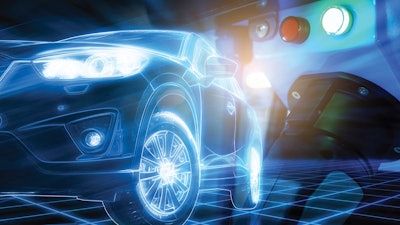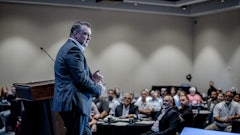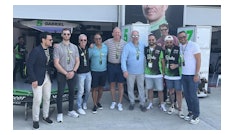
REFINISHING SAFETY CONSIDERATIONS WITH EVS
Within the global collision repair market, much of the attention regarding EV repairs has centred on one critical issue: the safety of technicians during repair and refinishing.
This column focuses primarily on the refinish process, exploring key concerns and offering preliminary answers to questions that remain unclear.
Since their mainstream emergence, electric vehicles (EVs) have become a focal point in global discourse, commanding signifi cant media coverage, regulatory interest, and public debate. Th eir promise to reshape the transportation landscape is both disruptive and deeply complex. Th is attention is driven by a combination of technological promise, environmental urgency, and unresolved user challenges.
In the main, these so-called column inches have concentrated on mainstream issues such as:
• ENVIRONMENTAL ISSUES
EVs are at the heart of global strategies to reduce greenhouse gas emissions and combat climate change concerns.
• INFRASTRUCTURAL LIMITATIONS
One of the most significant barriers in the eyes of the consumer is charging speed and availability.
• RANGE ANXIETY
Despite continuous improvements in battery capacity, range anxiety remains a psychological barrier.
• CULTURAL AND ECONOMIC DISRUPTION
EVs challenge entrenched norms and industries.
The extensive media coverage of EVs reflects a perfect storm of transformation: environmental urgency, consumer adaptation, technological risk, and market evolution. As governments push toward net-zero targets, EVs will continue to dominate both headlines and boardroom strategies, making them one of the most watched industries of the 21st century.
KEY REFINISHING ISSUE: HEAT EXPOSURE
Many industry communications highlight baking temperatures during refinishing as a major concern. American Honda issued the following guidance on LinkedIn:
“American Honda would like this message to act as a reminder regarding Paint Booth considerations when repairing Honda and Acura EV products, as reflected in our Service Information Site (SIS):
• Do not use the paint booth heating system for curing applied structural adhesives— use only infrared heaters.
• Maximum paint booth baking temperatures must not exceed 140°F (60°C) and 30 minutes of bake time.
• The high-voltage battery temperature must not exceed 105°F (40.5°C).
Failure to follow these specifications could result in damage to the HV battery or cause a thermal runaway event.”
This issue—temperature limitations—is the most frequently cited concern. Yet, deeper issues remain insufficiently addressed, particularly regarding flammable vapour risks during the application process.
KEY STAGES IN THE REFINISH PROCESS
There are three main steps:
1. Preparation of the surface to accept paint or coatings.
2. Application of coatings within a spray booth.
3. Drying or curing of coatings.
The spray booth environment is classified (e.g., Class 1, Division 1 per NFPA 70 / NEC) due to the presence of flammable vapours. Within such an environment:
• All equipment must meet ATEX / IECEx / UL hazardous location certification. • Common devices like cell phones are not compliant and should not be present.
• EV components, including batteries, are not rated for explosive environments unless they are within certified enclosures.
SAFETY REQUIREMENTS FOR EVS IN SPRAY BOOTHS
If placing an EV in a Class 1, Division 1 booth is unavoidable, consider:
• BATTERY SYSTEM ISOLATION
Full electrical disconnection of the high-voltage (HV) system.
• HAZARDOUS LOCATION CERTIFICATION
EV components exposed in the booth would need full certification—expensive and often impractical.
• GROUNDING PROTOCOLS
To prevent static buildup and discharge.
• PURGE & PRESSURIZATION SYSTEMS
For controlling internal booth atmosphere.
• CONTINUOUS GAS DETECTION
To ensure flammable vapour levels remain below the lower explosion limit (LEL).
Conclusion: Standard EVs are not suitable for spray environments with flammable vapours without major modifications. The risk of ignition from HV systems or undetected faults is too high without full certification and isolation.
EV BRIEF HISTORY
Let’s get one thing straight—EVs are not new. The first electric vehicle was developed in the early 19th century. Here is an overview of the timeline of their very early development:
• 1828–1835
Pioneers in the Netherlands, the United States and even Hungary were creating small-scale electric motors and early electric car prototypes.
• 1870–1880
Increasingly more practical electric cars were being developed, including by British inventor Thomas Parker, who built an electric vehicle in 1884 using non-rechargeable batteries.
• 1890–1891
In Des Moines, Iowa, William Morrison, a local chemist, built the first successful American electric vehicle, which could carry six passengers for up to 14 miles.
• 1900
Electric vehicles accounted for around one-third of all the vehicles on American roads.
BATTERY SYSTEM ISOLATION WITHOUT REMOVAL
Isolating an EV battery system without removal is vital for safety in collision repair environments, especially during paint application.
Methods include:
• SERVICE DISCONNECT (MSD):
Breaks the HV circuit—standard in many EVs.
• DISCONNECTING THE 12V AUXILIARY BATTERY:
Deactivates control electronics that could re-enable HV systems.
• ACTIVATING OEM SAFE MODES:
Software modes like “service” or “tow” mode electronically isolate the system.
• LOCK-OUT/TAG-OUT (LOTO):
Physically prevents reactivation during work.
• INSULATING HV COMPONENTS:
Use covers or blankets to prevent accidental contact.
Always:
• Use Class 0 PPE rated to 1000V.
• Follow manufacturer repair manuals.
• Verify voltage is zero using a multimeter.
LIMITATIONS OF ISOLATION TECHNIQUES
Even after isolation:
• They DO NOT stop internal chemical reactions or prevent thermal runaway.
• Service disconnects and 12V disconnections only stop power flow—not internal battery faults.
• Software isolation cannot prevent overheating or venting from compromised cells.
• LOTO & insulation reduce shock risk but do not eliminate fire hazards.
FINAL THOUGHTS
The repair and refinishing of EVs demands a complete rethinking of traditional methods. It’s not just about controlling bake temperatures— it’s about understanding:
• The thermal limits of EV batteries.
• The explosion risks in spray environments.
• The limitations of current safety practices.
As EV adoption grows, the collision repair industry must evolve standards, training, and protocols to meet the unique and potentially hazardous realities of electric vehicles.

























